NCERT Class 11 Biology Chapter 11 Notes Transport In Plants- Download PDF Notes
NCERT Chapter 11 transport in plants deals with the uptake and transport of water, minerals, and food in plants. The NCERT Class 11 Biology chapter 11 notes cover a brief outline of the chapter Transport in Plants. The important topics covered in this chapter of NCERT Class 11 Biology Notes are definitions, means of transport, plant water relations, xylem transport, phloem transport, transpiration, and Mass Flow Hypothesis. Class 11 Biology chapter 11 notes cover all the important concepts with examples and diagrams of this chapter in easy and simple language. The NCERT Class 11 chapter 11 notes are a part of NCERT Class 11 unit 4 Plant physiology. Having revision notes and NCERT Solutions for Class 11 Biology Chapter 11 handy at the time of the CBSE exam is beneficial to save you time. The NCERT Class 11 Biology chapter 7 notes PDF can be downloaded through the link given below.
This Story also Contains
- NCERT Class 11 Biology Chapter 11 Notes
- Means of Transport
- Simple Diffusion:
- Facilitated Diffusion:
- Active Transport:
- Plant-Water Relations
- Osmosis:
- Plasmolysis:
- Imbibition:
- Long Distance Transport of Water
- How Do Plants Absorb Water?
- Transpiration
- Uptake and Transport of Mineral Nutrients
- Phloem Transport: Flow from Source to Sink
- The Pressure Flow or Mass Flow Hypothesis
Transport in plants Class 11 notes Biology Chapter 11 also covers all the important headings, diagrams, and examples of NCERT books that are useful in various competitive exams. Chapter 11 Transport in Plants notes help you revise all major concepts given in the NCERT Book in a short period of time for CBSE Board exam preparation. Download the CBSE Notes for Class 11 Biology Chapter 11 PDF for a better experience and use them offline anywhere. Students must go through each topic in Transport in plants Class 11 Notes Biology in the easiest and most effective way possible with the help of NCERT Notes for Class 11. Check the given Class 11 Biology Notes Chapter 11 Transport in plants PDF for quick revision.
Also, students can refer to:
NCERT Class 11 Biology Chapter 11 Notes
Transport in plants Class 11 notes include topics: active and passive transport, water potential, osmosis, plasmolysis, uptake, and translocation of mineral ions, and mass flow hypothesis. CBSE Class 11 Biology chapter 11 notes include all of the major subtopics. From the perspective of the test, the CBSE Class 11 Biology chapter 11 notes also provide quick revision to remember. The learner may readily acquire all of the subjects stated here from the Class 11 Biology chapter 11 notes pdf download.
Means of Transport
Plants need to move organic nutrients, water, minerals, and phytohormones over short and long distances. Flowering plants do not have any type of circulatory system. Transport over a short distance is done by either simple diffusion or cytoplasmic streaming. Long-distance transport or translocation of substances is carried out by vascular tissue systems- xylem and phloem in flowering plants.
Simple Diffusion:
Diffusion is a passive means of transport used for moving substances over short distances. Substances move from a region of their higher concentration to lower concentration. It is a slow process and takes place even in non-living systems. Gases are transported exclusively via diffusion in plants. The rate of diffusion depends on the concentration gradient, membrane permeability, temperature, and pressure.
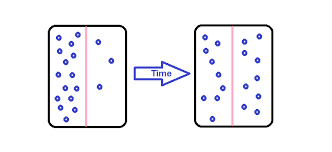
Facilitated Diffusion:
Substances move along the concentration gradient without the expenditure of energy. Used for transporting substances having hydrophilic moiety, since these cannot pass through cell membrane easily, therefore special proteins in cell membrane form channels to facilitate this diffusion. Facilitated diffusion is specific, sensitive to inhibitors, and bound to saturate when all protein transporters are being used.
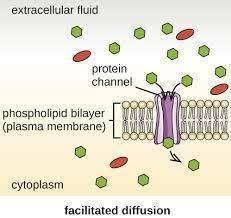
Porin proteins create enormous holes in the outer membranes of plastids, mitochondria, and some bacteria, allowing molecules as tiny as small proteins to pass through. Eight distinct types of aquaporins make up the water channel.
Symport and Antiport
During symport transport, two different types of molecules across the cell membrane simultaneously in the same direction. A transport in antiport occurs only when two different types of molecules simultaneously pass through the membrane in opposite directions. Uniport transport is independent of the movement of other molecules.
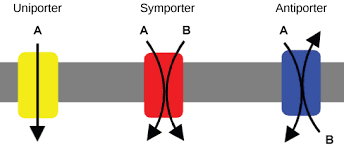
Active Transport:
Pump proteins are used to move molecules against the concentration gradient by using energy. Transport involving energy expenditure is called active transport. Proteins carrying out active transport are specific, sensitive to inhibitors reacting to protein side chains, and bound to saturate when all protein transporters are being used.
Plant-Water Relations
Water is the most abundant molecule in the protoplasm, it provides the aqueous medium in which most substances are dissolved and is essential for all of the plant’s physiological functioning. Plants absorb a lot of water from the soil but most of it gets evaporated due to transpiration happening in leaves. Due to its high demand, water is often a limiting factor in growth and productivity.
Water Potential
Water potential (represented by Ψw) is a metric to measure the concentration of kinetic energy of water molecules, the greater the free energy in water molecules, the greater their water potential. It is measured in pressure units like Pascal (Pa). Ψw is the sum of solute potential (represented by Ψs) and pressure potential (Ψp). Adding solute to water limits the movement of water molecules. The lowering of water potential due to the addition of any solute is known as solute potential, Ψs is always negative. The change in Ψw due to external pressure applied is determined by Ψp. Although negative potential or tension in the water column in the xylem plays a vital role in water transport up a stem in plants, pressure potential is generally positive. At standard temperature and atmospheric pressure, pure water has a maximum water potential of 0 Pa. All solutions have a lower (negative) water potential than pure water.
Ψw = Ψs+ Ψp
Osmosis:
The movement of water molecules from an area of greater concentration to a region of lower concentration through a selectively permeable membrane is known as osmosis. The net flow of water will be observed across the membrane until equilibrium is established across the selectively permeable membrane. The external pressure to be applied on the membrane to prevent the net flow of water is known as osmotic pressure. It is numerically equal to solute potential but opposite in magnitude.
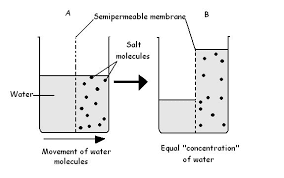
Plasmolysis:
Solutions balancing the osmotic pressure of the cytoplasm are termed isotonic solutions. Cells remain in a flaccid state in an isotonic solution.
If the external solution happens to be dilute with respect to the cell cytoplasm, such solutions are termed hypotonic solutions. Cells swell up due to water gain due to osmosis and become turgid. The pressure applied by cell walls onto the cytoplasm is called the turgor pressure, it is equivalent to pressure potential on the protoplasm.
Hypertonic solutions have higher solute concentration as compared to the cytoplasm, therefore cells exposed to a hypertonic solution will lose water due to osmosis. Excessive loss of water will result in plasmolysis, but this process is usually reversible. Cell membranes of plasmolysed cells shrink away from the cell wall. If it shrinks too much then plasmolysis becomes irreversible and the cell dies.
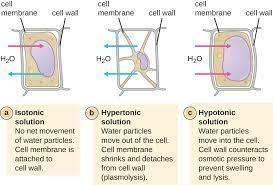
Imbibition:
Imbibition (a special type of diffusion) is the process through which water is absorbed by solids. Imbibition results in an increase in the volume of the solids. Seeds absorb water and hence swell up to build pressure, this helps seeds to emerge out of seedlings. For imbibition to take place, a water potential gradient must be present and an affinity between absorbent and imbibing liquid has to be there.
Long Distance Transport of Water
Xylem vascular tissue system is primarily responsible for unidirectional translocation of water up the plants from roots towards leaves. Xylem also translocates minerals, some organic nitrogen, and plant hormones.
How Do Plants Absorb Water?
- Absorption of water takes place in the roots. The surface area for water absorption is exponentially increased by root hairs that are thin-walled slender extensions of root epidermis, present on root tips. Water and minerals are absorbed by the root hairs via diffusion. Further movement of this absorbed water into the root can be either through symplast or apoplast pathways.
- The apoplast pathway allows the passive movement of water molecules as water molecules don’t have to pass through any cell membrane. This pathway is formed by adjacent cell walls that are continuous throughout the plant, except at the Casparian strips of the endodermis. Adhesive and cohesive properties of water are responsible for the mass flow of water through the apoplast pathway. Most of the water transport occurs via the apoplast pathway.
- Water passes through the cytoplasm of the cells in the symplast pathway. The cells are interconnected via protoplasmic strands called plasmodesmata. The movement of water is along the concentration gradient and relatively slower than the apoplast pathway. Cytoplasmic streaming can assist water movement in the case of the symplast pathway.
- Suberin deposition in the Casparian strips makes it a water-tight band so at the endodermis, layer water must follow the symplast pathway to enter the vascular bundles. Water follows the apoplast pathway in xylem vessels and tracheids as these are non-living. Plants can also form symbiotic associations with fungi to increase water and mineral absorption. The fungal partner receives carbohydrates from the plant, and this mutualistic relationship is termed mycorrhiza.
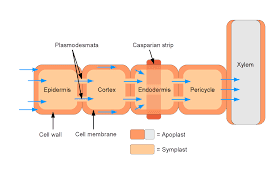
Water Movement Up A Plant
The translocation of water against gravity from roots to aerial parts is due to two complementary mechanisms- Root pressure and transpiration pull.
Root Pressure
Positive hydrostatic pressure in the xylem is developed by root pressure that is a consequence of active water absorption by root tissues. It can transport water up to small heights in stems and, important for re-establishing the continuous flow of water molecules that break due to tension in the xylem. When evaporation is low, water pushed by root pressure can be seen as droplets at leaf margins of some herbaceous plants, this phenomenon is called guttation.
Transpiration Pull
Negative hydrostatic pressure in the xylem is a result of tension created by water evaporation through stomata (transpiration), this is referred to as the cohesion-tension-transpiration pull model. The rate of translocation can be up to 15 meters per hour. Prominent during the day when sunlight is there to fasten evaporation.
Transpiration
Only less than 1% of water absorbed by roots is utilized in photosynthesis, rest is evaporated through stomata. Stomata also serve as sites for oxygen and carbon dioxide exchange, they are often closed at night. The Turgidity of guard cells regulates the opening of the stomatal aperture. Stomata open when guard cells are turgid and it closes when these cells become flaccid.
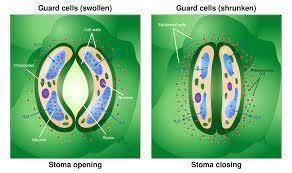
The rate of transpiration depends upon temperature, light (intensity and wavelength), relative humidity, wind speed, number and distribution of stomata (lower surface of the dorsiventral leaf has more stomata, while in isobilateral ones they are equally distributed on both surfaces), percent of open stomata, water status of the plant, canopy structures, etc.
Cohesion, adhesion, and surface tension are the properties of water that provide high tensile strength and capillarity. Transpiration pull can pull water up to 130m high.
Transpiration and Photosynthesis: a Compromise
Plants require a large amount of water for photosynthesis.
6CO2 + 6H2O → C6H12O6 + 6O2.
Both transpiration and photosynthesis are essential for the normal physiological functioning of the plant, but both have a high water demand, therefore there is always a compromise to be made. Besides maintaining transpiration pull and mineral transport, transpiration also cools down the plant by up to 10-15 ˚C and is necessary for maintaining the turgidity of plant cells. C4 plants have evolved to efficiently use water, they can fix twice CO2 as C3 plants for the same amount of water.
Uptake and Transport of Mineral Nutrients
Plants get oxygen and CO2 through the atmosphere; other nutritional requirements are fulfilled by absorbing minerals from the soil.
Uptake of Mineral Ions
Mineral ions are charged hence cannot pass through the lipid bilayer of cell membranes; therefore, absorption must be facilitated; also, they are more concentrated in the cytoplasm as compared to the soil therefore active transport is required for mineral uptake. ATP is used as an energy source.
Translocation of Mineral Ions
Minerals are translocated through the transpiration stream in the xylem. Apical and lateral meristems, young leaves, and other developing parts such as flower, fruit, seed, and storage organs act as main sinks for minerals. P, N, S, K are readily mobilized. Calcium is not re-mobilized.
Phloem Transport: Flow from Source to Sink
Phloem vascular tissue systems translocate food (as sucrose) from source to sink. Phloem transport is bidirectional, i.e., food can be translocated in the direction of the sink from the source in an upwards or downwards direction. Phloem sap is composed of water and sucrose primarily, but small amounts of other sugars, hormones, and amino acids are also present.
The Pressure Flow or Mass Flow Hypothesis
Phloem transport is explained by the pressure-flow or mass flow hypothesis. Loading of sucrose in phloem is by diffusion concentrates the phloem to become hypertonic. Water from the adjacent xylem moves into the phloem by osmosis. Phloem sap moves to an area of lower osmotic pressure. When sucrose reaches the sink, it is actively moved out from the phloem, resulting in decreased osmotic pressure in the phloem, therefore water will move to the adjacent xylem. At the sink, this sucrose can be used to derive energy or can be converted into storage carbohydrates.
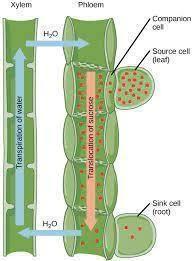
Chapter-Wise NCERT Class 11 Notes Biology
NCERT Class 11 Biology Chapter 11 Notes |
Subject Wise NCERT Exemplar Solutions
- NCERT Exemplar Class 11 Solutions
- NCERT Exemplar Class 11 Maths
- NCERT Exemplar Class 11 Physics
- NCERT Exemplar Class 11 Chemistry
- NCERT Exemplar Class 11 Biology
Significance of NCERT Notes for Class 11 Biology Chapter 11:
Class 11 notes on transportation in plants will help you review the chapter and have a better understanding of the important topics covered. This NCERT Class 11 Biology chapter 11 notes may also be used to cover the important concepts of the CBSE Biology Syllabus in Class 11 as well as for competitive examinations such as the NEET.
Subject Wise NCERT Solutions
Frequently Asked Questions (FAQs)
-The lowering of water potential due to the addition of any solute is known as solute potential.
Transport of substances over long distances via xylem and phloem tissues is called translocation.
Transpiration is required for:
Generating transpiration stream in xylem
Supplying water and minerals to all parts of the plant
Cooldown the plant by up to 10-15 ˚C by evaporative cooling.
Maintaining the turgidity of plant cells.
Minerals are absorbed against their concentration gradient, therefore energy in the form of ATP is required to operate protein pumps that can absorb mineral ions.
Calcium
Cohesion, adhesion, and surface tension are the properties of water that provide high tensile strength and capillarity.
Popular Questions
Courses After 12th
Applications for Admissions are open.
As per latest syllabus. Physics formulas, equations, & laws of class 11 & 12th chapters
JEE Main Important Chemistry formulas
Get nowAs per latest syllabus. Chemistry formulas, equations, & laws of class 11 & 12th chapters
JEE Main high scoring chapters and topics
Get nowAs per latest 2024 syllabus. Study 40% syllabus and score upto 100% marks in JEE
JEE Main Important Mathematics Formulas
Get nowAs per latest syllabus. Maths formulas, equations, & theorems of class 11 & 12th chapters
